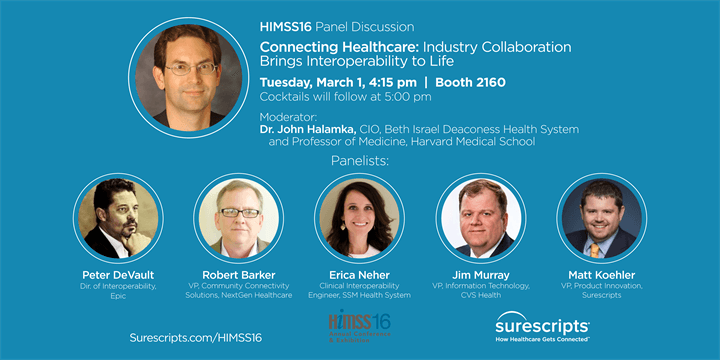At its core, what is the ideal state of interoperability? How far are we from achieving that utopia, and where must we focus in the near future to achieve progress and move interoperability forward? In advance of HIMSS16, we posed similar questions to a few of our industry partners and featured speakers at our HIMSS panel on advancing interoperability, including the following:
- Bob Barker, Vice president of community connectivity at NextGen Healthcare
- Erica Neher, Clinical Interoperability Engineer at SSM Health System
They each hail from organizations who play a critical role in driving health information exchange and collaboration across the industry.
Check out their responses below, and hear more from our entire panel of experts—including esteemed discussion moderator, CIO of the Beth Israel Deaconess Health System and Professor of Medicine Harvard Medical School, Dr. John Halamka, as well as leaders from Epic and CVS Health--on March 1, 4:15pm PT, at Surescripts’ booth #2160!
Q. What do you see as the ideal state of interoperability; and how far are we from achieving it?
- Barker: I see the ideal state of interoperability as one where a clinical user of HIT has all relevant clinical information for a patient at the point of care and in their normal workflow, so that the clinical user will be able to use this information to improve patient care, and ultimately show improved patient outcomes. The information shared should be integrated into the patient chart and include pre-coordinated data as well as contextual data. Collectively, the industry still has a way to go to achieve this ideal state, but we are certainly closer than we were 5 years ago.
The standards that have taken hold in the industry are finally reaching a point where vendors are adopting them and implementing them in a way that allows HIT users to begin realizing benefits. While the process has been slow-going, the recent launch of the Surescripts National Record Locator Service (NRLS) [leveraging the Carequality framework] is a big step forward. However, there are key issues that still have not been addressed. Specifically, the ancillary connections that the HIT vendors must connect to for regulatory compliance. Until we get the Immunizations, Syndromic, Cancer registries, Labs etc. agreeing to a single standard, IG and transport, we will continue to struggle as an industry.
- Neher: The ideal state of interoperability involves the ability to share patient information between providers and patients in the safest and securest manner with the fewest number of barriers at the time of the visit. This need is expanding to require that this information is available to the entire care team in time to manage population health and immediately respond to changes in patient condition/risk in order to intervene and prevent a bad outcome. We need interoperability and analytics to inform us as the healthcare industry moves toward disease prevention and health maintenance.
However, in order for interoperability to really be valuable, it must be usable. More information is only better if it can be utilized without requiring significant manual effort to incorporate that data into the native chart.
We are closer than we have ever been in the past to this model with a lot of industry movement such as Carequality and Surescripts’ NRLS, legislative interest, new standards and a more app-centric approach to sharing information. However, we need to push further and faster to drive value, reduce cost, eliminate unnecessary intermediaries and remove barriers.
Q. Where is your organization focused in terms of furthering industry-wide interoperability in 2016?
- Barker: NextGen Healthcare believes that interoperability is in the best interest of all HIT users; providers and patient alike, not just NextGen users. We have worked side by side with many competing HIT companies in the EHRA, KLAS, HIMSS, Argonaut, Sequoia (Carequality), Direct Trust and other industry-focused organizations. We expect to continue to work in these settings to advance interoperability between all systems. FHIR is growing as a better overall solution for opening up the EHR’s data to external systems and applications, and we are actively developing solutions and working with other vendors that are implementing FHIR-based solutions. We also believe that the Surescripts NRLS is one of the best chances for industry wide adoption for real time data sharing and patient location services, and its use of the Carequality framework will make the implementation of this network much easier than previous attempts of this scope.
- Neher: As SSM Health moves towards assuming increasing risk for patient populations, having information on care provided outside of the SSM care platform is increasingly important for quality reporting, understanding utilization and managing risk, and managing population health. We recognize that patients have choice in where they obtain care and that we will be held accountable for the cost of their care even if it occurs outside of our system.
Interoperability is rapidly evolving and there are a variety of ways to get outside patient information. We must focus on the technologies that provide the widest and most comprehensive access to patient information. We must also focus on those technologies that not only prioritize obtaining information but focus on how the information will be used. Our goal in 2016 is to expand our reach for external information and to make responsible choices around technology spend to help us reach these goals.
Be sure to visit Surescripts’ booth—#2160—at HIMSS on March 1 and join us for a panel discussion moderated by Dr. John Halamka at 4:15pm followed by a cocktail reception.



 Dean Riggott Photography
Surescripts
Dean Riggott Photography
Surescripts